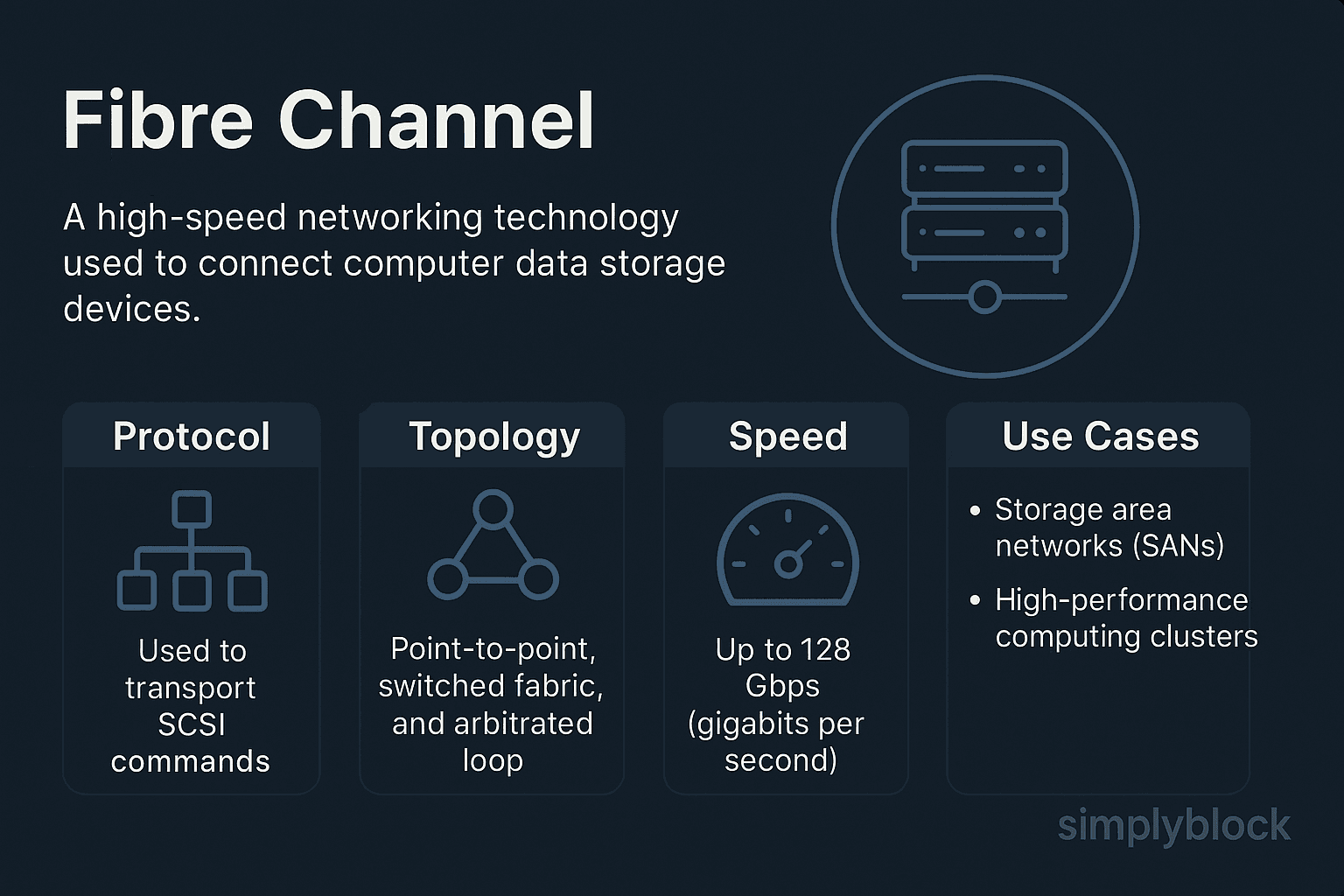Fibre Channel
Terms related to simplyblock
Fibre Channel (FC) is a high-performance network technology primarily used for transmitting data between storage systems and servers in data centers. It enables block-level data transfer across Storage Area Networks (SANs), delivering low latency, high throughput, and high reliability. Fibre Channel operates independently of IP protocols and is commonly used in environments requiring sustained performance, such as mission-critical databases, virtualized workloads, and backup infrastructures.
Despite its name, Fibre Channel supports both optical fiber and copper cabling. It typically runs at speeds ranging from 8 Gbps to 128 Gbps, using dedicated switches and Host Bus Adapters (HBAs) to form lossless, low-latency fabrics.

How Fibre Channel Works
Fibre Channel uses a layered protocol architecture (FC-0 to FC-4) and employs point-to-point, arbitrated loop, or switched fabric topologies. The most common deployment is the switched fabric, where all devices communicate via one or more Fibre Channel switches. Each device—typically a server or storage array—requires an HBA to interface with the Fibre Channel fabric.
Fibre Channel carries the SCSI command set, enabling block storage over dedicated infrastructure. Its deterministic performance and isolation from general-purpose IP networks contribute to predictable storage access, a critical requirement for high-transaction workloads.
Fibre Channel vs NVMe/TCP – A Comparative View
Though Fibre Channel remains entrenched in legacy environments, modern cloud-native architectures are increasingly moving toward IP-based alternatives like NVMe/TCP, which offer similar performance with more flexibility.
Here’s how Fibre Channel compares:
| Feature | Fibre Channel | NVMe/TCP |
|---|---|---|
| Protocol | FC-SCSI | NVMe over TCP/IP |
| Transport | Proprietary (lossless) | Standard Ethernet |
| Latency | Sub-millisecond | Sub-millisecond (with NVMe optimization) |
| Hardware | Requires FC HBAs & switches | Uses standard NICs |
| Scalability | Moderate (data center scale) | High (cloud & hybrid ready) |
| Cost & Complexity | High CAPEX & OPEX | Lower TCO, better flexibility |
Use Cases of Fibre Channel
Fibre Channel is primarily deployed in enterprise environments that require:
- High IOPS and Low Latency: Mission-critical databases such as Oracle, SAP, and Microsoft SQL Server.
- Virtualization: Backend storage for large VMware and Hyper-V environments.
- Backup and Disaster Recovery: Fast and consistent data transport for secondary storage systems.
- Data Warehousing: Reliable connectivity for structured storage systems.
However, for organizations scaling into Kubernetes, hybrid clouds, or edge deployments, Fibre Channel presents operational limits compared to disaggregated, software-defined options like NVMe-over-TCP.
Why Fibre Channel Adoption is Declining
While Fibre Channel provides strong isolation and performance, it lacks the flexibility and openness required by modern DevOps, edge, and multi-cloud strategies. Key limitations include:
- High total cost of ownership due to specialized hardware
- Complex lifecycle management, requiring SAN administrators
- Incompatibility with container-native infrastructure
- Limited agility in scale-out storage deployments
Enterprises are increasingly seeking SAN alternatives like simplyblock’s NVMe-over-TCP platform, which uses commodity Ethernet, removes FC dependencies, and integrates seamlessly with orchestration platforms like Kubernetes.
Fibre Channel in the Era of Software-Defined Storage
In the shift toward modular and disaggregated infrastructure, software-defined storage platforms are replacing Fibre Channel with protocol-agnostic architectures. Fibre Channel’s rigid requirements around zoning, fabric management, and vendor lock-in conflict with cloud-native storage principles.
Solutions like simplyblock embrace NVMe, erasure coding, and scale-out fabrics, offering high availability and performance without the constraints of Fibre Channel.
Review these resources to better understand how Fibre Channel compares in modern storage stacks:
- Kubernetes Storage Best Practices
- NVMe Over Fabrics vs. iSCSI vs. Fibre Channel
- Advanced Erasure Coding in SDS
- Database Performance Bottlenecks
External Resources
- Fibre Channel – Wikipedia
- SCSI over Fibre Channel (T10.org)
- Brocade Fibre Channel Switches – Broadcom
- Cisco Storage Area Networking Solutions
Questions and Answers
Fibre Channel (FC) is a high-speed network protocol used to connect servers to storage in SAN (Storage Area Network) environments. Known for low latency and high reliability, it’s commonly used in enterprise data centers for block storage workloads and mission-critical applications.
Fibre Channel delivers fast, consistent performance but requires specialized hardware and switches. In contrast, NVMe over TCP offers similar latency and throughput over standard Ethernet, making it more scalable, flexible, and cloud-native friendly.
Fibre Channel can be used in Kubernetes with custom drivers, but it lacks native integration and flexibility. Kubernetes-native NVMe storage provides better support for dynamic provisioning, automation, and scalability in containerized infrastructures.
Fibre Channel itself does not handle encryption. To secure data, encryption must be managed at the storage or volume level. Solutions like Simplyblock offer encryption at rest for secure, compliant storage deployments.
Fibre Channel offers strong performance but is costly, rigid, and lacks integration with modern DevOps and cloud-native stacks. Software-defined storage using NVMe/TCP provides a more agile and cost-effective alternative for scalable environments.
